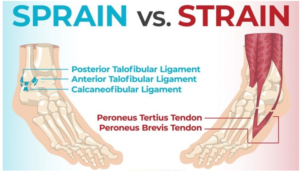Muscle Strain and a Muscle Sprain
A muscle strain and a muscle sprain are both injuries to the body’s soft tissues, but they affect different structures. Understanding the difference between these two injuries can help in identifying the cause, providing the right treatment, and preventing further damage. Below, we discuss the key differences between muscle strains and muscle sprains, their symptoms, causes, and treatment approaches.

What is a Muscle Strain?
A muscle strain refers to the injury of a muscle or tendon (the tissue that connects muscles to bones). It occurs when the muscle fibers are stretched or torn due to overuse, overstretching, or excessive force.
Causes of Muscle Strain:
- Sudden movements or twisting motions that overstretch the muscle.
- Lifting heavy objects improperly.
- Sports-related injuries where muscles are suddenly overexerted.
Symptoms of Muscle Strain:
- Pain in the affected muscle, especially when it’s moved or contracted.
- Swelling or bruising around the injured area.
- Limited range of motion and muscle weakness.
- Muscle spasms in the affected area.
What is a Muscle Sprain?
A muscle sprain refers to the injury of a ligament—the tissue that connects bones to other bones. A sprain occurs when a ligament is stretched or torn due to an injury that causes excessive force or strain on the joint.
Causes of Muscle Sprain:
- Twisting or rolling of a joint, especially in activities that involve sudden movements.
- A fall or a direct blow to the body, such as during a contact sport.
- Overuse or repetitive motion, leading to a weakened ligament.
Symptoms of Muscle Sprain:
- Pain at the affected joint, especially when the joint is moved or touched.
- Swelling or bruising around the joint.
- Limited mobility and difficulty using the joint properly.
- Instability in the joint, feeling of weakness or loss of strength.
Key Differences Between Muscle Strain and Sprain
Affected Structures:
- Strain: Involves muscles and tendons (soft tissue connecting muscles to bones).
- Sprain: Involves ligaments (fibrous tissue connecting bones to bones).
Causes of Injury:
- Strain: Occurs due to overstretching or overuse of muscles or tendons.
- Sprain: Caused by twisting or stretching a ligament beyond its normal range of motion, often in a joint.
Symptoms:
- Strain: Pain, swelling, muscle spasms, and weakness in the affected muscle.
- Sprain: Pain, swelling, bruising, instability, and difficulty moving the affected joint.
Common Locations:
- Strains often occur in muscles like the hamstrings, back, and calf.
- Sprains typically happen in joints such as the ankle, knee, or wrist.
First Aid for Muscle Strains and Sprains
Immediate Treatment for Both Strains and Sprains (R.I.C.E.)
- Rest: Allow the injured area to rest and avoid using it for a period of time.
- Ice: Apply an ice pack to the injured area for 15-20 minutes at a time to reduce swelling and numb the pain.
- Compression: Use an elastic bandage to apply gentle compression to the injured area. This can help reduce swelling.
- Elevation: Keep the injured part raised above heart level to reduce swelling.
For Strains:
- Apply gentle stretching after the initial healing period to restore flexibility.
- Gradually strengthen the muscle with specific exercises to prevent further strain.
For Sprains:
- Immobilization may be required, especially if there is significant ligament damage.
- In more severe sprains, a brace or splint may be used to support the joint.
Treatment for Muscle Strains and Sprains
Non-Surgical Treatment:
- Rest and icing are the first steps to reduce swelling and prevent further injury.
- Pain relievers: Over-the-counter pain medications like NSAIDs (ibuprofen) can help alleviate pain and inflammation.
- Physical therapy: A physical therapist may guide the patient through exercises to improve mobility, strength, and flexibility in the affected area.
- Elastic bandage or brace: A bandage or brace may be used to reduce swelling and offer support.
Severe Injuries (Surgery):
- Surgery may be required for severe sprains where the ligament is torn or severely damaged. Strains that involve significant tears in muscle fibers may also require surgical intervention in extreme cases.
Prevention of Strains and Sprains
- Warm-up and cool-down: Proper warm-up exercises before engaging in physical activity can help prepare the muscles and joints for movement.
- Proper technique: Ensure that lifting or exercising is done using proper technique to avoid unnecessary strain or stress.
- Strengthening muscles: Regular exercise to strengthen muscles and improve flexibility can help prevent both strains and sprains.
In summary, while muscle strains and muscle sprains are both common injuries, they differ in the type of tissue affected and the underlying causes. Strains affect muscles or tendons and are caused by overuse or overstretching, while sprains affect ligaments and are usually caused by trauma, twisting, or excessive force on the joints. Early treatment with the R.I.C.E. method and professional guidance for rehabilitation can help manage these injuries and promote healing.
If you’re experiencing persistent pain, especially after muscle strains or sprains, devices like Curapod, which uses electrical stimulation, can be effective in reducing pain, promoting circulation, and helping you recover faster. Incorporating Curapod in your treatment regimen can complement other therapies and provide relief, allowing for a quicker recovery.
References
- Mayo Clinic, 2025. Strains and Sprains: Symptoms and Causes. Available at: https://www.mayoclinic.org/diseases-conditions/strain-and-sprain/diagnosis-treatment/drc-20352974 [Accessed 28 February 2025].
- American Academy of Orthopaedic Surgeons (AAOS), 2025. Strains and Sprains: Treatment and Prevention. Available at: https://www.aaos.org/diseases–conditions/strains-and-sprains/ [Accessed 28 February 2025].
- Tang, P., 2019. Difference Between a Strain & Sprain Explained. Available at: https://www.thephysioclinicbristol.co.uk/difference-between-a-strain-sprain-explained/ [Accessed 28 February 2025].


